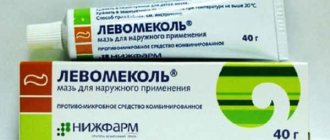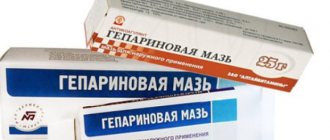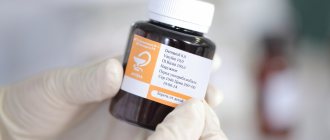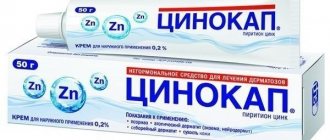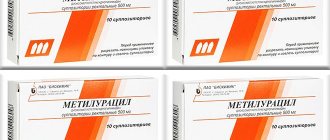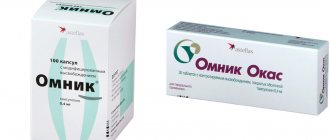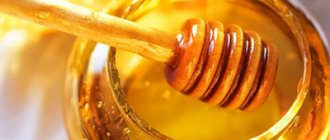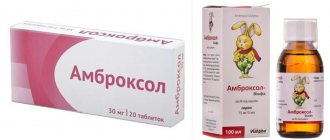Oflomelid is an ointment with a combined composition used to treat infected lesions of the integrity of the skin.
The complex action provides simultaneously a disinfecting, analgesic and regenerating effect.
Highly active against gram-positive microorganisms: Staphylococcus spp. (including Staphylococcus aureus, Staphylococcus epidermidis), Streptococcus spp.; gram-negative microorganisms: Pseudomonas aeruginosa, Acinetobacter spp., Escherichia coli, Klebsiella spp., Proteus spp., Enterobacter spp., Citrobacter spp.; anaerobes: Propionibacterium acnes; intracellular microorganisms: Chlamydia spp. (including Chlamydia trachomatis), Legionella spp., Mycoplasma spp.
Release form and composition
White ointment is packaged in polymer jars (200 and 400 g each), aluminum tubes (30 g each) and dark glass jars (1000/2000 g each). The cardboard pack contains instructions from the manufacturer with recommendations and 1 tube/jar.
Content of active substances in 100 g of ointment:
- dioxomethyltetrahydropyrimidine (methyluracil) – 4 g;
- lidocaine hydrochloride monohydrate – 3 g (in terms of lidocaine hydrochloride);
- ofloxacin – 1 g.
Additional components: methyl parahydroxybenzoate, macrogol 400 and 1500, propylene glycol, propyl parahydroxybenzoate.
Pharmacological effect
The effect is achieved due to the peculiarities of the influence of each of the three components:
- Lidocaine hydrochloride - the component is responsible for local anesthesia by obstructing the conduction of impulses along nerve fibers. Local application of the substance causes vasodilation, increased oxygen flow and improved cell nutrition.
- Ofloxacin is an antimicrobial component with a wide spectrum of activity. It works by blocking the synthesis of DNA proteins in bacterial cells, causing them to die. Microorganisms sensitive to the component: staphylococcus, hydrophilic aeromonas, brucella, enterobacter, streptococcus, pseudomonas, proteus, chlamydia, legionella, mycoplasma.
- Methyluracil - stimulates the processes of restoration of tissue elements, accelerates wound healing, accelerates the growth and maturation of granulation tissue. It is widely used in surgery to accelerate the healing of postoperative sutures.
When applied, the complex drug simultaneously suppresses the activity of pathogenic microorganisms, minimizes the inflammatory process, accelerates regeneration processes and has an analgesic effect. The ointment is especially valued due to its ability to quickly relieve redness, swelling, and restore complex damage.
Pharmacological properties of the drug "Oflomelid", pharmacokinetics
As already mentioned, Oflomelid ointment has an antimicrobial, analgesic and regenerating effect. This effect is achieved through a combination of three active components.
- Ofloxacin in the drug gives a strong antimicrobial effect. This action is based on the blockade of DNA gyrase in bacterial cells. Shows high activity against many gram-positive microorganisms (staphylococci, streptococci) and gram-negative (acytobacteria, Escherichia, Klebsiella, enterobacteria).
- Methyluracil is a tissue regeneration stimulator. It has anabolic activity. In addition, it enhances cell regeneration processes by enhancing their growth and granulation maturation of tissues.
- Lidocaine in Oflomelid is a local anesthetic. The drug blocks sodium channels, which prevents the generation of impulses in the endings of sensory neurons and the conduction of impulses along nerve fibers. When applied to the surface of the skin, it is able to dilate blood vessels without causing a local irritant effect.
The ointment contains a water-soluble hydrophilic base. It provides a dehydrating effect on tissue, which is 20 times greater than the hyperosmotic effect of a 10% sodium chloride solution. Data on the pharmacokinetics of Oflomelid are not provided.
Indications for use
The drug has an intense antibacterial focus, suppressing the synthesis and reproduction of DNA in pathogenic microbes. As a result, DNA harmful to the human body loses stability and the bacterial cell dies.
Oflomelid is used externally for the following pathological processes:
- Trophic ulcers.
- Boils, purulent pimples.
- Infected burns - up to IV degree inclusive.
- Bedsores (with purulent discharge, initial stage of necrosis).
- Wounds, purulent, infected, of any origin with intense pain.
- Wound injuries after surgical opening of carbuncles, abscesses, boils, hidradenitis with suppuration (an infectious disease with inflammation of the sweat glands, or the so-called “bitch udder”), phlegmon.
Also used for hemorrhoidal inflammation. Since ofloxacin suppresses pathogenic microorganisms in areas of inflammation of soft tissues and the pelvis, and methyluarcil in the form of suppositories has shown excellent results in the treatment of hemorrhoids, stimulating cellular immunity, the drug can be successfully used in this pathology. In addition to the effect on hemorrhoidal lesions of the first components, the anesthesia provided by lidocaine is an additional positive factor for pain in the anal area.
Properties Oflomelid
The pharmacological properties of this combination drug allow it to be used in dermatology, traumatology and other areas of medicine. How does Oflomelid ointment work and what does it help? His actions are as follows:
- anti-inflammatory;
- regenerating;
- anesthetic;
- antimicrobial;
- healing;
- decongestant.
Ofloxacin is an antibiotic
(fluoroquinolone) broad-spectrum. It blocks the enzyme DNA gyrase in bacterial cells, without which reproduction and repair of microbial DNA is impossible. As a result, the genetic material of the infection is destabilized and the cell dies.
The following bacteria are sensitive to antibiotics:
- gram-negative aerobes (Campylobacter, Brucella, Salmonella, Yersenia, Shigella, Klebsiella, Haemophilus influenzae, Moraxella, etc.);
- gram-positive aerobes
(various types of staphylococci, streptococci); - anaerobes
(Helicobacter pylori, clostridia); - mycoplasma
, legionella, chladidium, etc.
The ointment, according to the instructions for use, copes well with most pathogens that are resistant to other local antimicrobial agents.
The pronounced effect is achieved due to the presence of highly active components from different medicinal groups.
Methyluracil
- stimulator of tissue repair. It has anabolic activity, increases the rate of cell recovery, granulation tissue maturation, and epithelization. Lidocaine is an anesthetic that blocks the transmission of pain impulses into neurons. Improves blood microcirculation, helps increase nutrition of damaged tissues.
Levomekol ointment is very popular in doctors' prescriptions. So which is better - Oflomelid or Levomekol? The latter remedy also contains an antibiotic (chloramphenicol) and methyluracil, but does not include an anesthetic. Therefore, it is better to use Levomekol in the absence of pain and the need to “freeze” the injury site. Otherwise, Oflomelid is more suitable for treatment.
The main indication for the use of Oflomelid is the treatment of infected skin wounds of various origins. It is especially indicated to use the drug for wounds with purulent-necrotic processes and intense pain. For the treatment of burns of any location, Oflomelid is suitable up to grade 4 severity, including infected burns.
Other indications:
- trophic ulcers on the lower extremities and other parts of the body;
- bedsores - initial or with purulent processes, with the first stages of tissue necrosis;
- purulent pimples - single and multiple;
Oflomelid ointment is often used in the treatment of hemorrhoidal cones in the rectal area, both external and internal. Ofloxacin suppresses microbial inflammation, and methyluracil helps heal wounds and cracks in the mucous membrane.Lidocaine in the ointment is an excellent remedy for quickly relieving hemorrhoidal pain; it will help even with severe pain.
The drug should not be used by pregnant women, lactating women, under 18 years of age, or with hypersensitivity to the components.
Contraindications
The use of Oflomelid ointment is contraindicated in several pathological and physiological conditions of the body, which include:
- Pregnancy at any stage of its course.
- Lactation period (breastfeeding).
- Hypersensitivity to the active substances or auxiliary components of the drug.
- Children and adolescents under 18 years of age.
Before starting to use Oflomelid ointment, you should make sure that there are no contraindications.
Main indications for the use of Oflomelid ointment
The main indications for the use of Oflomelid ointment are:
- Infected burns of 2–4 degrees.
- Trophic ulcers.
- Bedsores.
- Postoperative wounds, fistulas.
- Purulent wounds.
- Wounds accompanied by pain.
- Wounds after opening phlegmons, abscesses.
- Boils.
- Lipomas.
- Hemorrhoids (external and internal).
- Felon.
- Infectious eczema.
- Abscessing periodontitis in dentistry.
Dosage and method of administration
The instructions for use indicate that Oflomelid ointment is used externally, 1 time/day for 1-2 weeks. The maximum daily dose should not exceed 100 g of ointment. The duration of treatment depends on the dynamics of cleansing wounds from purulent exudate and the timing of relief of the inflammatory process.
After standard treatment of wounds and burns, the ointment is applied directly to the wound surface in a thin layer (after which a sterile gauze bandage is applied) or on a gauze bandage, followed by application to the lesion.
Tampons soaked in ointment are loosely filled into the cavities of purulent wounds after surgical treatment, and gauze turundas with ointment are inserted into the fistula tracts.
When treating infected burns, the drug is used daily or 2-3 times a week, depending on the amount of purulent discharge.
Directions for use and dosage
Oflomelid ointment is applied externally to the damaged area after antiseptic treatment. Application is carried out with careful movements, in a thin layer, after which a sterile bandage can be applied. The recommended frequency of treatment is once a day for 1-2 weeks, depending on the complexity of the damage. Burn surfaces can be treated more often - up to three times a day. The amount of composition applied per day should not exceed 100 grams.
If the wounds are deep, they are covered with gauze swabs soaked in ointment. Turundas made of gauze, also treated with the drug, are inserted into the fistulas. The feasibility of extending therapy is determined by the doctor based on the dynamics of the healing process.
Reviews
We have selected some reviews from people who have used Oflomelid ointment:
- Anna. I used Oflomelid to eliminate bedsores after six months of lying in a cast. Bedsores on my back have already begun to turn into painful ulcers in some places. My husband helped treat the wounds and apply ointment. Then he covered them with a gauze bandage. The situation was aggravated by suppuration of the wounds. The procedure was repeated twice a day. The ointment relieves pain and helps wounds heal quickly. In two weeks, the bedsores disappeared and only pinkish traces remained. The ointment is very effective and at the same time its price is reasonable.
- Ivan. I used the ointment after my boil was removed. At first it didn’t bother me much and I just smeared it with iodine the old fashioned way. When it swelled and festered, I went to the hospital. After the operation, it was necessary to find a good healing ointment. A friend brought Oflomelid to try, he used it himself after a burn. The ointment literally began to heal the wound before our eyes. Within a week it had healed significantly. I applied it twice a day and covered it with a gauze bandage. I used the ointment for two weeks in total; I didn’t need any more.
- Zhenya. I tried Oflomelid for the first time to heal a wound after appendicitis surgery. About five dressings ended perfectly, but then the seams began to get wet, ichor began to appear constantly and pus was released. I found Oflomelid at the nearest pharmacy and made a dressing with it. I treated it with peroxide and then with a thin layer of Oflomelid. The wound was covered with a breathable bandage. Dressings were carried out three times a day. The stitches began to scar very quickly and within a week they had already noticeably healed.
Reviews about Oflomelide
Reviews about Oflomelid are only good:
- Magic remedy;
- Shocking results!;
- This is a tool that we surgeons have long dreamed of.
Among its advantages, patients include:
- rapid healing of any wounds and burns;
- relieves redness;
- has warming properties;
- faint odor;
- pleasant texture;
- no discomfort during use;
- no side effects;
- absorbs well;
- lack of interaction with other medications;
- does not clog pores;
- long shelf life;
- low price.
There are a lot of rave reviews, all of them confirm the high effectiveness of Oflomelid:
- This is a magical remedy for healing any wounds, even very deep ones. Within a day of using it, the wounds on my legs began to heal, and on the fourth day they completely disappeared. Now this ointment will always be in my medicine cabinet.
Some patients cited its oily structure as a disadvantage; there are complaints that it spreads when applied to the skin.
A tube of Oflomelid (30 g) costs from 103 to 188 rubles.
Analogs
There are no structural analogues of Oflomelid.
Analogs by pharmacological group (antimicrobials):
- Abisil;
- Baneocin;
- Biopin;
- Dermazin;
- Levomekol;
- Levomethyl;
- Levomycetin;
- Levosin;
- Lingesin;
- Metrogil;
- Metronidazole;
- Metroseptol;
- Riodoxol ointment;
- Rosamet;
- Rosex;
- Streptonitol;
- Sulfargin;
- Tetracycline;
- Tomicide;
- Trofodermin;
- Fastin 1;
- Fugentin;
- Fuzimet;
- Furasol;
- Chlorophyllin OZ;
- Chlorophyllipt;
- Chlorophyllipt solution in oil 2%;
- Chlorophyllipt alcohol solution;
- Eplan.
Before using analogues, consult your doctor.

